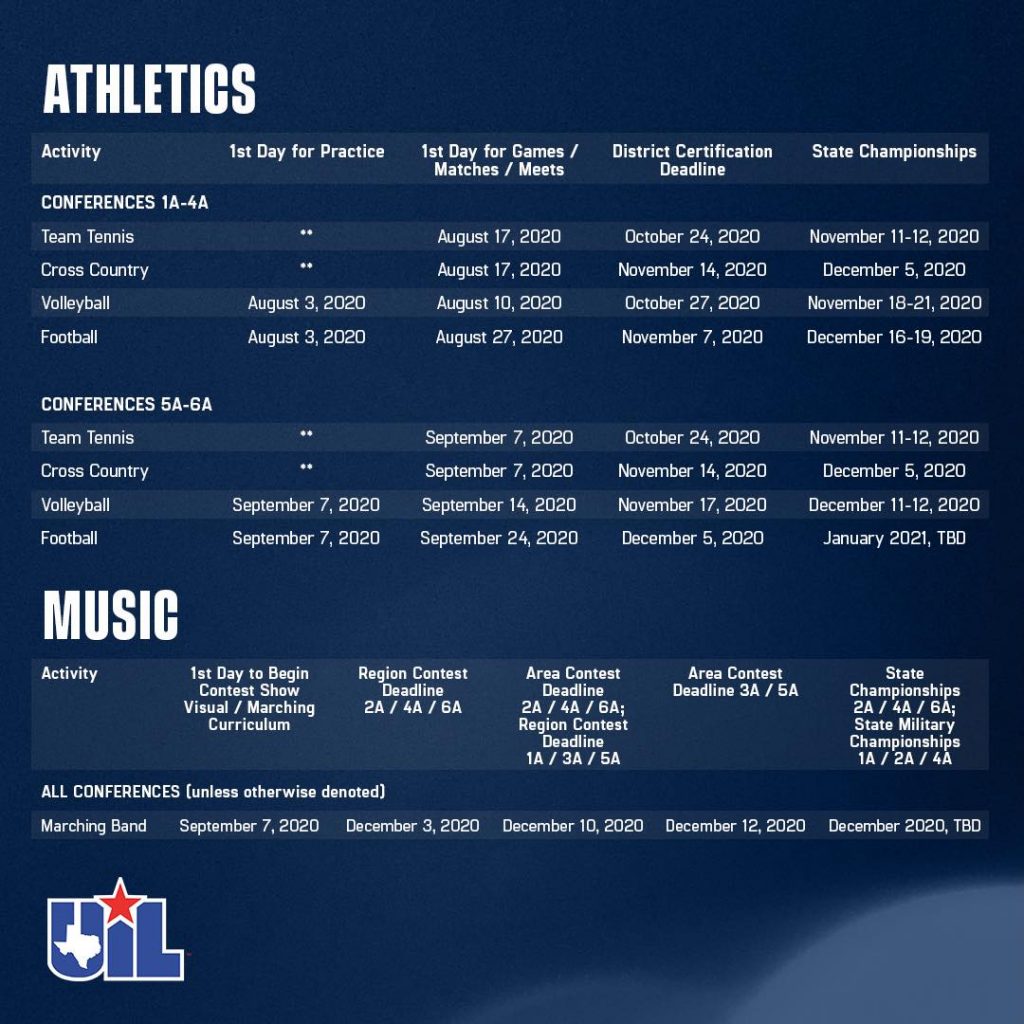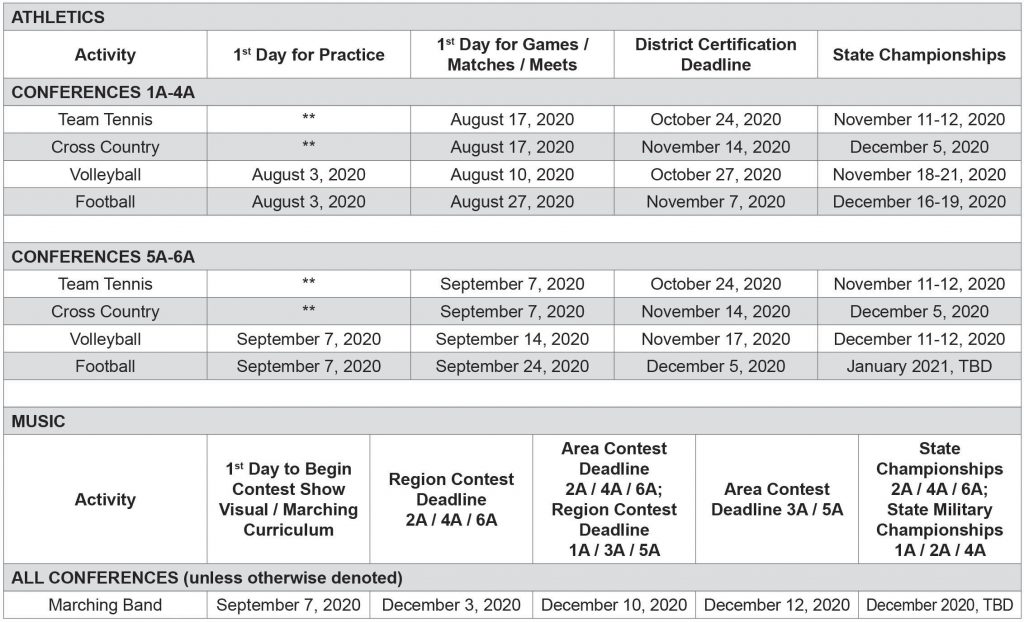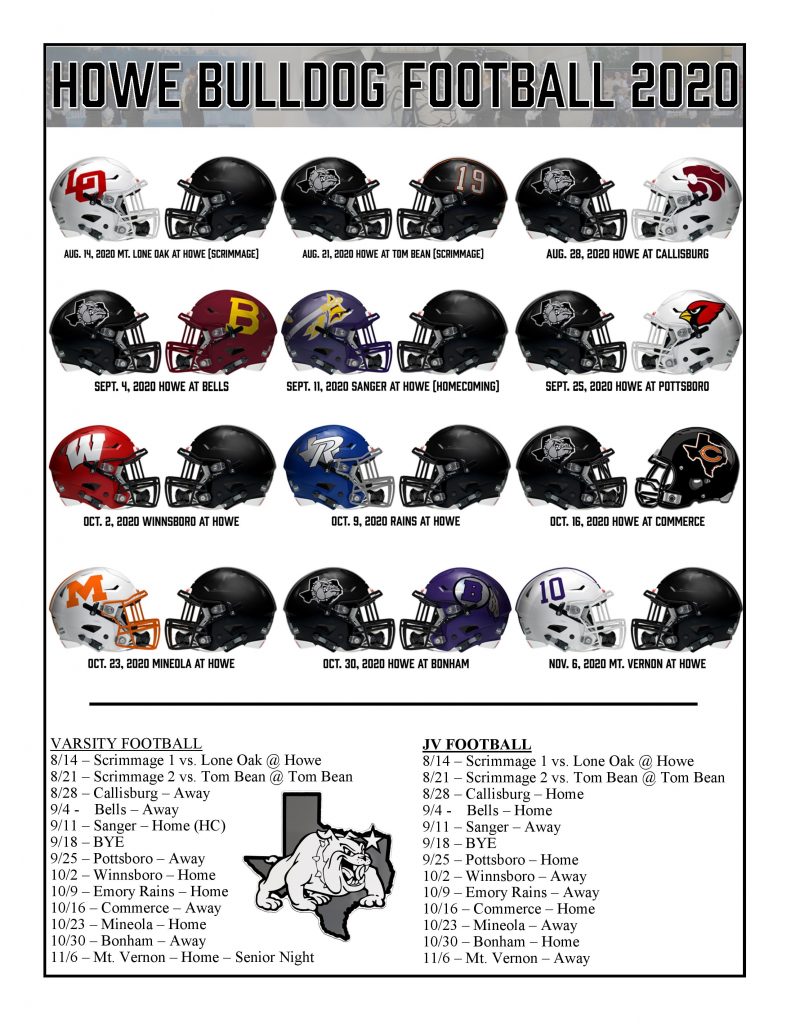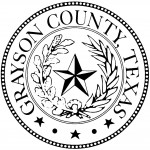Click the photo below for the full document.

The University Interscholastic League (UIL) announced today that schools in Class 1A-4A will start practices and games while Class 5A-6A will start practices Sept 7th and games on September 24th. Sherman and Denison are affected in the Class 5A-6A, while other surrounding small schools will start on time.
While football always grabs the headlines, this affects all fall sports with volleyball getting the big jump on Aug. 10 for first games while cross country and tennis begin competition on Aug. 17.

UIL Press Release below
The University Interscholastic League (UIL) is presented modifications to the 2020-2021 UIL calendar and updated COVID-19 risk mitigation guidelines, set to take effect August 1, 2020.
The modifications to the 2020-2021 calendar differ by activity and conference and can be found on the UIL website and in the chart below. These adjustments reflect the public health situation at this time and the varying numbers of COVID-19 cases across different geographic areas of the state. This plan provides a delay for schools in highly-populated metro areas, primarily conferences 5A-6A, given the challenges with COVID-19 those communities are facing, while providing schools in other areas, primarily 1A-4A, an opportunity to start seasons on schedule. Acknowledging the situation is not always clear-cut and that COVID-19 affects every community differently, the plan also allows for local flexibility and encourages districts to plan for possible interruptions in order to complete district seasons.

Additionally, the COVID-19 risk mitigation guidelines for the 2020-2021 school year can be found at this link. This includes guidance around face coverings, general operations and protocol for individuals confirmed or exposed to COVID-19, congregate settings (band halls, locker rooms, etc.), practice and rehearsal activities, spectators and media, and concession stands and food service.
These guidelines are in addition to guidance issued by the Texas Education Agency (TEA) and intended to be implemented along with TEA guidance, which applies to UIL academic activities and extracurricular non-UIL activities.
With the understanding that not all schools will be able to start at the same time, this plan allows for schools to make playing decisions at the local level, and the UIL will work directly with schools that have scheduling issues not addressed in this plan to allow them flexibility to complete as many contests as possible.
“Our goal in releasing this plan is to provide a path forward for Texas students and schools,” said UIL Executive Director Dr. Charles Breithaupt. “While understanding situations change and there will likely be interruptions that will require flexibility and patience, we are hopeful this plan allows students to participate in the education-based activities they love in a way that prioritizes safety and mitigates risk of COVID-19 spread.”
UIL will continue to work with state officials and monitor CDC and other federal guidance to determine any potential modifications that may become necessary.


At the birth of our Republic we fought a war to gain sovereignty over the right to vote and determine our destiny as citizens. Yet, as we celebrated the 244th Fourth of July this past week, we find ourselves on the threshold of surrendering our rights anew, throwing away our right of self-determination by accepting unsecure elections.
A pandemic, riots, and political rancor have given rise to factions and rules that undoubtedly have diminished our individual liberties in myriad ways—from dining out to funerals and religious worship. But also under attack is that same civic right of electing our leaders. The calls to accept mail-in ballots are growing louder, despite the many documented risks.
There is civil unrest in most major cities of the nation where history is being destroyed in literal fashion, local governments cowed, and agitators seeking to abolish law enforcement. Chaos here cannot be abetted by adding that of a contested November election to the volatile mix and surrendering to the “little tyrants” our founders so often warned that populate big government. Simply put, we patriots should be aware that the peril we faced in 1776 isn’t so very different from now when an election can be stolen and our Republic imperiled.
Now, as then, we face a grave threat to the integrity of that civic participation’s survival. Established factions have grown powerful and controlling. Among them, we count political parties, and special interests that threaten the choices for citizens and their natural right to control their destiny and choose their governors.
Sadly, many people have become too frightened to leave their homes to exercise this right. They have become myopically convinced that filling out an absentee ballot is the only safe manner to cast their vote. But there are dangers inherent in an all-mail-in ballot process.
There is a body of documented evidence that shows that mail-in ballots are rife with opportunity for large scale vote theft. Even under non-pandemic conditions and in times that aren’t as panic-stricken, mail-in ballots have been utilized by well-funded vote harvesters. With an all-mail-in ballot system, the opportunity for vote harvesting is exponentially increased. While some states already do conduct vote by mail operations, these operations were not built in a day—they’ve had years. Done wrong, we ignore the lessons of the past.
Have we forgotten then the cause for celebration of the Fourth of July? On that day in 1776, a document was signed, declaring freedom, liberty, and independence from a controlling establishment, thus reversing the political relationship of subject and sovereign. It set down in writing that rights come from God and not government. It gave birth to our Republic (and resulted in a war of independence to gain those rights. It led to the formation of a government to secure those rights “ …deriving their just powers from the consent of the governed…”.
Chief among those right is the right to vote and determine our own destinies.
That right of self-determination means little if an illegitimate vote cancels out a legitimate one.
If that right is stolen or undermined, consent of the governed is no longer a worry for those in power. This leads to a lack of trust in the system and foments unrest—not unlike what the original American Colonies faced in 1776.
What a perfect opportunity to remind ourselves that we are those enfranchised to select our leaders. It’s a right worth protecting.
Happy 244th Independence Day. May we celebrate many more!
Former U.S. Rep. Francisco “Quico” Canseco leads the Election Protection Project at the Texas Public Policy Foundation.
Press Release to the voters of Grayson County, Texas June 26, 2020

Early voting begins Monday, June 29, 2020 and ends on July 10, 2020 for the Grayson County Democratic Primary Runoff Election. Voter and poll worker safety at the polls is our top priority in Grayson County. We ask our voters to join us and participate in the recommended voter health safety plan to continue to keep our county safe during this voting season. Elections in 2020 will be conducted with the recommended health protocols advised to our department from the Texas Secretary of State. If you have questions, please call our office at 903-893-8683 or email us at votegrayson@co.grayson.tx.us. Additional information is also available on the county website: www.co.grayson.tx.us.
The following are the minimum health safety plan recommendations in place for the Primary Runoff Election. Individuals are encouraged to adopt additional protocols consistent with their specific needs and circumstances to help protect the health and safety of all poll workers and voters.
Recommended health protocols for voters:
1) Wear a face mask covering nose and mouth. If a poll worker needs to verify identity of the voter, they will ask for the mask to be removed briefly then replaced for the duration of the voting process. Masks will be provided if needed.
2) Disinfect hands upon entering and exiting the voting area along with practicing cough etiquette, cleanliness and sanitation.
3) Maintain at least six feet of physical distance between all others, where possible.
4) Use the clear glove provided to check in and vote on equipment.
5) Voters age 65 and older and voters who have pre-existing health conditions should consider staying at home and submitting an Application for Ballot by Mail (deadline for return of application is July 2), or voting curbside from their vehicles.
6) Self-screen before going to the polling place. Voters exhibiting any CDC-listed symptoms associated with COVID-19 should consider utilizing curbside voting at the polling place.
Recommended health protocols for poll workers:
1) Face shields, masks and gloves will be provided to the poll workers.
2) Consistently disinfect items that come into contact with voters.
3) Poll workers will self-screen for any CDC-listed symptoms before entering the polling place.
4) To the extent possible, maintain at least six feet between others at the polling place.
5) Arrange polling place and mark floor to allow voters to maintain six feet of separation from others.
Voting by Mail: A voter is eligible to vote early by mail if they are a registered voter who:
A. Is 65 years of age or older on Election Day;
B. Has a disability or illness defined as a sickness or a physical condition that prevents voter from appearing at the polling place without a likelihood of needing personal assistance or injuring voter’s health;
C. Expects to be out of the county during the hours that voting is conducted during early voting in person and on Election Day. An out of county address and the begin/end dates voter will receive mail at this address must be provided;
D. Is confined in jail, but eligible to vote due to 1) serving a misdemeanor sentence and will not be released prior to Election Day, or 2) pending trial or appeal after denial of bail or without bail or where release on bail before Election Day is unlikely.
To vote by mail, voters must first apply for a ballot. Applications are available by calling 903-893-8683 or visiting the Elections page on the county website. Applications must be received in our office mail by July 2, 2020.
Voting In Person During Early Voting for the Primary Runoff Election:
It is recommended voters appearing in person to vote do so during the two weeks of early voting and to arrive at non-peak times (mid-day and mid-afternoon) if possible to help social distancing and avoiding lines.
Early voting Dates and Times:
Monday – Thursday, June 29-July, 8am to 5pm
CLOSED Friday and Saturday, July 3-4
Sunday, July 5, noon to 5pm
Monday – Friday, July 6-10, 7am to 7pm
Early voting Sites:
Sherman, Election Administration, 115 W. Houston
Denison, Grayson County Sub-Courthouse, 101 W. Woodard
Pottsboro, ISD Administration, 105 Cardinal
Whitesboro City Hall, 111 W. Main
Van Alstyne, Grayson College South Campus, 1455 W. Van Alstyne Pkwy
Voting In Person on Election Day for the Primary Runoff Election:
Voter centers listed below will be open from 7:00am to 7:00pm on July 14, 2020. All eligible registered voters in Grayson County may vote at any of the Election Day sites.
| Bells | Bells City Hall | 203 S. Broadway |
| Collinsville | Collinsville Community Building | 117 N. Main |
| Denison | Grayson College, Gym foyer | 6101 Grayson Dr |
| Denison | Grayson County Sub-Courthouse | 101 W. Woodard |
| Denison | Parkside Baptist Church, Fellowship Hall | 301 N. Lillis Lane |
| Gunter | First Baptist Church | 99 Gentle Creek Lane |
| Howe | Howe Community Center | 700 W. Haning |
| Pottsboro | Pottsboro ISD Administration Bldg., Board Mtg. Room | 105 Cardinal Lane |
| Sherman | Election Administration Building | 115 W. Houston |
| Sherman | Texoma Council of Governments, Eisenhower Room | 1117 Gallagher Dr |
| Sherman | United Way of Grayson County | 713 E. Brockett |
| Tom Bean | First National Bank, Edwards Community Room | 109 S. Britton |
| Van Alstyne | Grayson College South Campus, Room 203 | 1455 W. Van Alstyne Pkwy |
| Whitesboro | Whitesboro City Hall | 111 W. Main |
| Whitewright | Church of Christ, Fellowship Hall | 606 S. Carter |